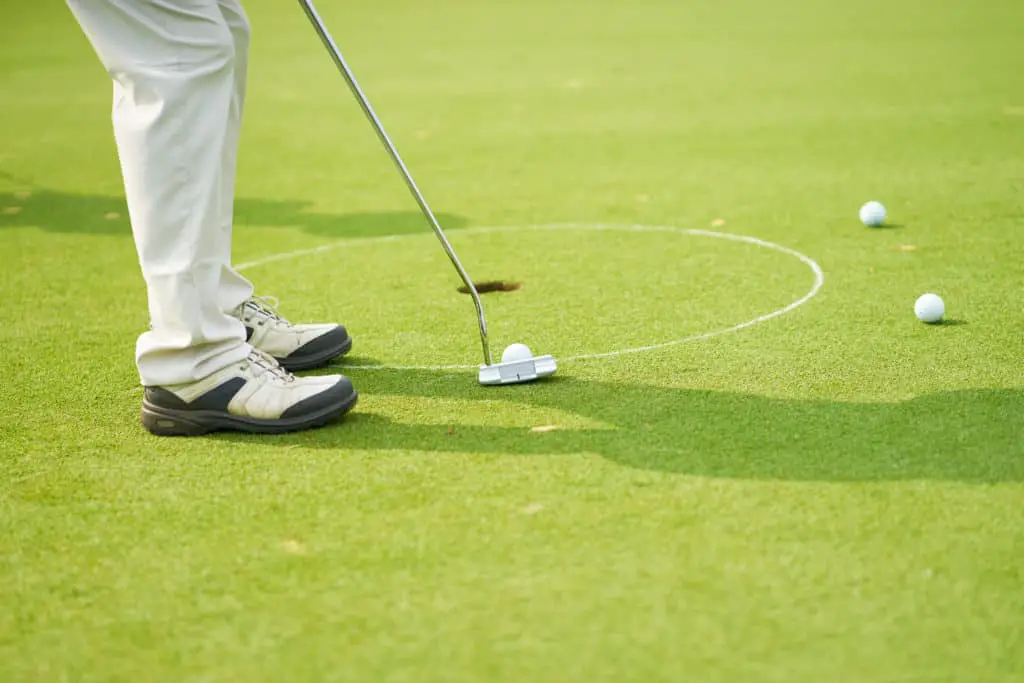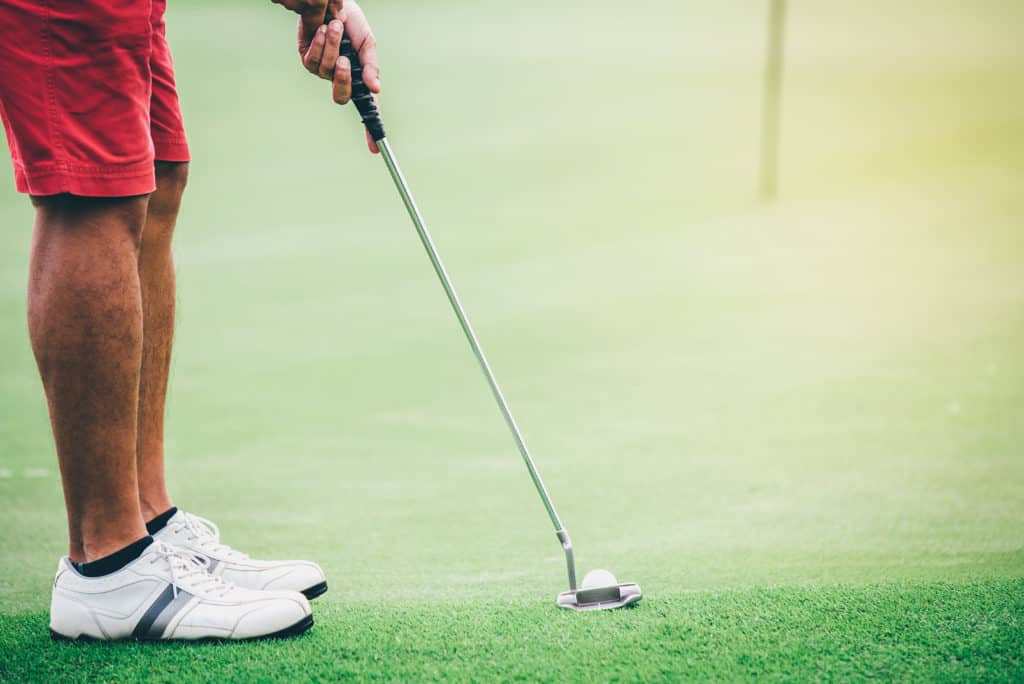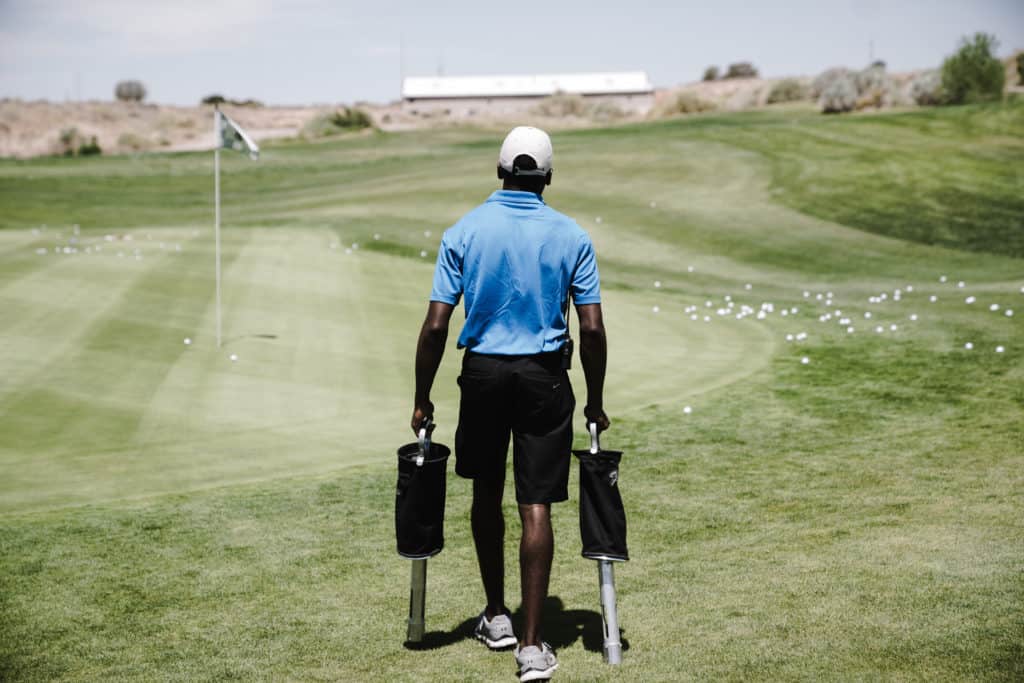The golfer should use the length putter that best enables them to start the ball on the intended line and the optimum speed for the line they have selected. Overall, the majority of golfers will choose between a 33 inch and 36 inch putter, or select a belly putter or long putter.
If you turn on the PGA Tour any given Sunday, you will see a variety of putters and putting styles.
The interesting thing about putting is that it doesn’t take great strength or speed.
Instead it takes the ability to 1) start the ball on your intended line at the 2) speed that is optimum for the line that you selected.
There is putting, pretty much wrapped up in two simple keys. Of course you have to be able to read greens and that comes with experience and many repetitions over the course of your golf journey.
What Length Putter Should I Use?
Update: I prefer a standard length putter, but would recommend trying out all of the different options if you struggling on the greens. However, first you should track your putt stats to ensure you surely are struggling on the greens. Too many golfers have too high of expectations and could start by comparing make percentages on the PGA Tour to their own. Did you know that the average make percentage on the PGA Tour from 8 feet is only 50%?
Let’s dive into some of the advantages and an overview of the different length putters.
- Standard 33-36 inch putters
- Belly Putters
- Long Putters

Standard Putters (Short Putters)
The majority of golfers will begin their journey with a standard putter. If they end up being a “good” putter with a standard length putter, they will probably stick with that style for the duration of their golfing days. However, at the first sign of struggle, you will see many golfers start to experiment with different length putters.
The benefits of the standard length putter is that it feels most natural and has a similar motion to a chip shot and a full swing shot. The golfer will use a pretty standard greip and take the club back and through with a comfortable movement of the shoulders and forearms. With the speed of the greens on golf course nowaday, you see much less wrist hinge or punching at the ball, which was more common the days of Arnold Palmer and Jack Nickalus.
The standard putter might be best for speed control, but as soon as the golfers starts to experience some “yips” with the putter, they will probably start to test out different options. The first putter that came along as an alternative putter was the longer putter.
Some golfers with the standard putter will often seek out the claw grip or left hand low style to stabilize the putter face throughout the stroke.
Helpful Post: When to use a putter (4 key situations!)
Belly Putters (Medium Putters)
When belly putters first came out, you would see professional golfers anchor the putter into their midsection. This provided an opportunity to stabilize the putter, which allowed the golfer to fit any yips type situation or whatever they were fighting in their standard putter stroke.
The USGA then made it illegal to anchor the putter to the body, so many professional golfers now use a belly length putter, but run it up the forearm to provide a stabilizing force and remove the flinching of the hands at the ball through the hitting zone.
These putters have saved the careers of many professional golfers who could strike the ball with the best on tour, but may have struggled with making those 3-10 putters that are so important on the tour.
Helpful Post: Is a new putter worth it?
Long Putters (Longest Option)
When I first recall long putters, they seemed to be everywhere on the Senior PGA Tour. Golfers with bad backs or those that struggled with their putting overall, would turn to the long putter. The golfers would often anchor the putter in the sternum area and try to create a back and forth pendulum like motion.
The long putters allowed golfers to spend plenty of time on the practice green as the posture with a longer putter would eliminate any soreness or tightness that might occur in the back from too many hours of practice with the standard putter.
Eventually, the anchoring rules came into play and the alternative putting stroke now appears to be the midsize putter where golf manufacturers can move the weight to different places to allow for the stabilization of the putter.
Helpful Post: How to putt with a mallet putter

Short Putter vs Medium Size Putter vs Long Putter: Which Length Putter Should I Use?
Putting is different than many of the other aspects of golf. If we were talking about driver length it is pretty simple that the longer the club, more frequently the further you will hit the ball. However, with the putter, the only true way to know what is best for each individual golfer is for the golfer to test out the different options.
Here is a step by step process that a golfer could take:
- Keep accurate stats on your putting stats that include total putts, putt percentage between 3-10 feet and the total length of putts for a round. (Minimum of 5 rounds)
- If your numbers are poor, consider adding a different length putter to your options.
- Play your next 5 rounds with a different putter and keep those same steps as in the first step.
- Determine which putter you are putting best with and make a selection and go for another 5 rounds, tracking your stats once again.
Another option is the following (practice green based):
- On the practice green take a ball and throw it to a random spot on the green 20-30 feet from the hole. Keep track of your number of 1 putts and 3 putts over 18 holes.
- Take your other putter and repeat the same process.
- Which putter provided the best stats?
A final option (practice green based):
- Setup a putting station at 10 feet. See how many putts you can start on the right line with the right speed. Go ahead and hit 20 putts.
- Go ahead and do the same thing with an alternate putter.
Completing these 3 assessments above will help you understand the analytics behind your different putter options.
Several years ago, I purchased an additional standard length putter. My first putter is a Scott Cameron that has more of a blade style. I purchased an Odyssey two ball putter. I went through this process of identifying the best putter and the two ball putter won out.
What I liked best about it was the extra weight in the putter head. This allowed me to create a smooth, patient stroke with the putter. The putter was able to work back and through without a “hit” in the stroke. I am better able to control the start line and the speed is spot on!
Is A Short Putter Better?
No, there is a not specific putter that is best for every golfer. Instead the golfer must complete different assessments of each putter they have available to them. Sometimes the golfer will go with the overall feel of a putter and one that provides the confidence needed to play a round of golf.
Golf often comes down to having confidence and being able to make a confidence stroke over the ball. Some people may throw all of the analytics out the window and go with what provides the most confidence to them.

Two Key Putting Drills
I believe there are two amazing putting drills that can help just about every golfer. They key to putting is 3 putt avoidance in the 30-40 foot range and the ability to make 3-10 footers. These are the two areas that analytics tell us are most important in the game of golf!
Drill #1
- Practice putts from 30-40 feet and attempt to get 10 out of 10 putts inside a 3 feet circle around the hole.
- This drill will help 3 putt avoidance on the greens.
Drill #2
- Practice putts between 3-10 feet and see how many you can make in a row.
- Challenge yourself to make 5, 10 footers in a row before you leave the course.
- If you get good at this, challenge yourself to that from multiple spots on the practice green or around that same hole.
Helpful Post: How to make more putts!
Manage Expectations on the Putting Green
Did you know that the make percentage on the PGA Tour from 8 feet is only 51%?
Some other key stats: Odd of one putting on PGA Tour?
| Less than 3′ | 4′ | 5′ | 6′ | 7′ | 8′ | 20′ |
| 99.40% | 92% | 80.80% | 70.30% | 60.90% | 51.80% | 12% |
You can see why the first drill from 30-40 feet is so important. Get the ball inside of 3 feet and you are just about set! Leave the ball at 6 feet and you only have a 70% chance of making it, even if you are on the PGA tour!
Practice those long putts and perfect your 3-10 footers as best as possible!
Take Action – What You Can Do Today to Get Better
What does this mean for you? I believe in the following recipe to get better:
1 – Improve your motion in the golf swing by identifying a golf instructor. Here are some options:
Here is a list of golf instructors that we have reviewed:
2 – Train to swing faster and improve your swing speed. Here are some options:
Looking to gain more Speed and Distance in your swing. Two Options:
3 – Understand course strategy and work to break through your next barrier. Here is a series on breaking through:
We have provided guides on how to break 100, 90, 80 and 70. Check out more below, if interested.
4 – Practice Frequently
Did you know that I build a golf simulator in my garage and have played over 500 rounds of golf on my SkyTrak system? It has been a game changer and one worth checking out. Here are some of my other posts on golf simulators frequently asked questions:
- Is a Golf Simulator Worth It?
- How to Build a Golf Simulator?
- What is the Best Golf Simulator?
- Golf Simulator Accessories?
- How to Build a Golf Simulator for under $7000
- Top 11 Reasons to Buy a SkyTrak
- How to Build a Golf Simulator for Under $1000
- Why Build A Golf Simulator?
- What Space is Needed?
- Can A Golf Simulator Improve My Game?
- How Much Does A Golf Simulator Cost?
- Don’t Forget to Check out our 15 best golf swings of all time.
